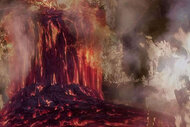Create a free profile to get unlimited access to exclusive videos, sweepstakes, and more!
A Gathering Storm

I was sitting in my office at home writing a post for the blog on Friday, when I glanced out the window. Although the Sun was shining on my yard, the sky itself was a dark, ominous gray filling the view. Afternoon storms in Colorado are common, but this one seemed different. So I went outside to look, and this is what I saw:
Yeah. That’s a panorama taken with my iPhone, and to be honest it collapses the scale horizontally a bit; this cloud was far larger than it seems in the photo, covering nearly 180° of the sky (click to get a much larger version of it).
This is a classic cumulonimbus storm cloud, complete with an anvil top, sometimes called a thunderhead. These form as warm, moist air rises rapidly (called convection). You get a trunk starting a kilometer or two off the ground and it puffs out a bit as it goes up. The rising air can be truncated by wind shear—higher altitude air moving rapidly that cuts off convection—or when it hits the tropopause, the boundary between the lower troposphere and the stratosphere at about six kilometers off the ground. The air spreads out rapidly, causing the round, flat-topped anvil.
In the picture, east is roughly to the left and west to the right (though it’s distorted in the pano). Wind typically blows west to east here at the foothills of the Rocky Mountains, and you can see the cloud is more extended on the left (east), blown back by the wind. You can also see rain falling under the base, and I think there may be some weak mesocyclone structure there, too.
While I don’t wish for heavy weather, it would’ve been nice to catch the edge of this one; it’s dry here. This system was a bit east of us and heading northeast, so it missed us. But we do get our share of amazing weather here, and I expect it won’t be long before we see more.
I’ve written about storms like this before; here’s some further reading with amazing photography and some jaw-dropping time-lapse videos:















